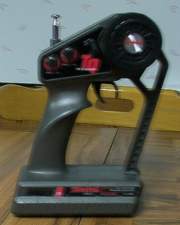Driving Tips
One of the most critical parts of knowing how to use your R/C car is (of course) knowing how to drive it. This page is really for beginners only; if you've driven an R/C car before, you probably know how they generally handle, and you probably understand the left-right steering thing. If you aren't familiar with these things, read on.
The Radio
One of the most important things used to control your car is your radio transmitter. Here are some tips for using your radio system.
- Make sure you read the directions for your radio before using it, or familiarize yourself with its controls in some way. Not all radio systems are the same, you know.
- Always be certain that you have fresh batteries in your radio. If your batteries give out in either your transmitter or your receiver's batteries give out, you may be looking at a runaway vehicle.
- Know the range of your car. If you drive your car out of range, it will continue in that direction until it receives contact with your transmitter again.
 If you have a pistol trigger-type transmitter, (it looks like this picture here) make sure that you never over-stress the steering wheel. If it has a foam pad around it, (like this Traxxas model here) you can pop off the foam and put a little petroleum jelly on it to let it slip a little of you over-stress it.
If you have a pistol trigger-type transmitter, (it looks like this picture here) make sure that you never over-stress the steering wheel. If it has a foam pad around it, (like this Traxxas model here) you can pop off the foam and put a little petroleum jelly on it to let it slip a little of you over-stress it.
Driving It
- Remember that left and right on the transmitter correspond to left and right from the car's perspective, not your own. This sounds very obvious, but the first few time that you try to drive the car, this makes it somewhat difficult to get used to.
- Note your car's turning radius, and its slipping points. Failure to do so could result in an out-of-control car or a crash (or both!).
- Going along with the last point, know how your car's braking system works. Most, if not all, gas-powered cars have actual breaks that are controlled by a third servo. However, electric cars are a different story. Forward-only ESC (Electronic Speed Control)-equipped cars often brake just by pulling back on the throttle trigger. Forward-and-Reverse ESC-equipped cars vary. Some do not have braking, and others will break for a set amount of time before reverse kicks in. Mechanical Speed Control (they have no breaking; all you can do is let it slow down in ample time.)
- For places to drive, try to find an open space, paved for an on-road car, or dirt for an off-road car. These are just ideal places, and if you are familiar with how your car handles, feel free to find a variety of places to drive in. Keep you car away from full-scale cars (like on a busy street) and pedestrians (yes, they can injure people -- it happened to me once).
